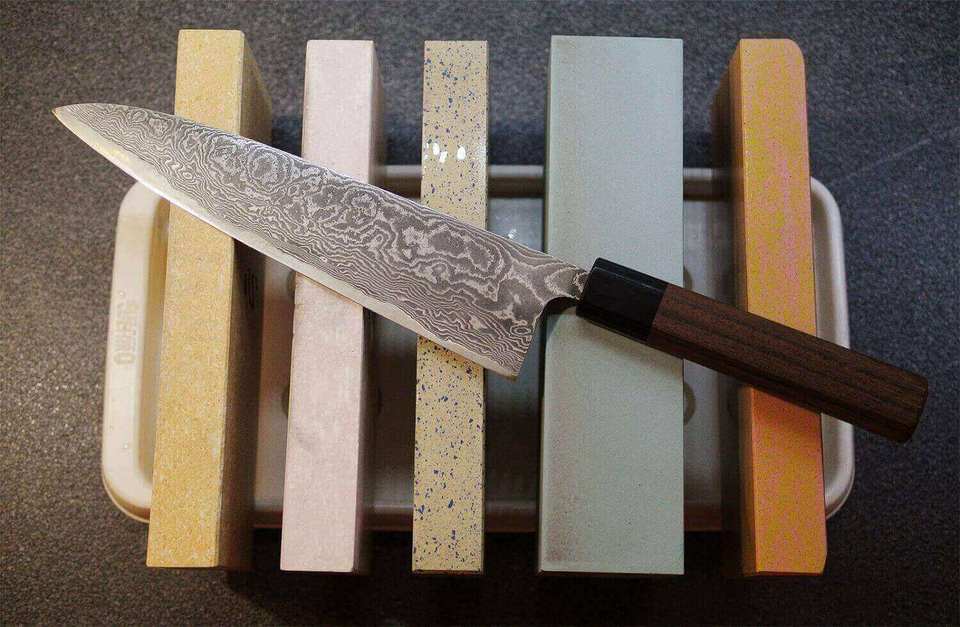Maintaining Your Maintenance Tools: Keeping your Whetstone in Top Shape

As many will tell you, knife sharpening and maintenance are key in the longevity and safety of one of your most vital kitchen tools, your knife. You can accomplish having your knife perfectly sharpened by using a variety of different maintenance tools. The most common of course is the whetstone.
However, purchasing this vitally necessary tool for your kitchen is only half the battle. In addition to keeping your knives maintained, you need to make sure that you are also taking care of the tool that does the maintaining.
But how do you keep your whetstone in pristine condition? What are the best steps to prolonging your whetstone’s life?
Here is a breakdown of all you need to know to maintain your whetstone in the kitchen.
What is a Whetstone?

If you don’t know what a whetstone is, it is usually a small rectangular block that has grit surface, almost like sandpaper. Some whetstones only have one grit, while others have two different grits on either side of the block. Usually, one side is rougher than the other to give your knives a nice overall sharpening.
It is a tool you can use to sharpen your knives about every few months or so. They are generally easy to use, extremely handy, and will leave your knives looking good as new. Of the tools available to use for sharpening knives, a whetstone tends to be the most popular.
How to Take Care of Your Whetstone
Soak Your Whetstone Through

As its name implies whetstones are used when wet. You will want to dampen your whetstone just prior to sharpening your knives. This would mean dampening it with water for 20-30 minutes beforehand. You can also leave it to soak in a small bath of water.
While you sharpen your knife be sure that your whetstone never goes dry. For the best performance and longevity of your whetstone, keeping it wet while in use is one of the most important rules.
Some whetstones can even be stored in water, but you will want to double-check that you can with your particular whetstone. Medium to rough course stones can usually be left in water, while fine or finishing stones shouldn’t be.
Added Tip: Each whetstone has the grit number labeled on the block. This is especially important if you have a whetstone with two different grits. Generally, after a whetstone’s first use that number may begin to fade away. A good habit is to take a waterproof marker and write in the grit number before each use.
This will help you keep track of what side of the whetstone you are using. Preventing any mistakes during the sharpening process.
Flip Your Whetstone

Another good habit to form is flipping your whetstone end to end before you use it. Even when you use your whetstone correctly you are bound to lean heavily on one side of the whetstone. In order to prolong the whetstone’s life flipping it to even out its surface on all sides is a good way to do just that.
This is an added technique that can help better level your whetstone as well.
Make Sure Your Whetstone is Level

Before you even bring out your knives you will want to make sure that your whetstone is level. Whetstones tend to wear out quicker in the middle and therefore won’t always be level on a hard surface.
If you are using it on a standard hard surface you will want to make sure there is no space between the whetstone and the surface. If there is you will have to level your whetstone before using.
The longer you use a whetstone the more likely this will happen and if not taken care of it will render the whetstone unusable. So, always be sure to check and see if your whetstone needs leveling.
Another option is if you have a wooden block holder to sit your whetstone into. Not only will a wooden holder help keep your whetstone level, but it also will hold it in place. This would help prevent any slipping while sharpening when you press the blade to the whetstone.
Don’t Sharpen the Wrong Tool

Now that your whetstone is primed for sharpening your knives lets take a look at the tools you want to your whetstone to sharpen. While whetstones are known for removing dents and microscopic metal build-up on your kitchen knives, they won’t necessarily work for all your tools.
If you find yourself needing to sharpen something that requires a good amount of metal removal, it would be best to find an alternative before turning to your nice whetstone. Too much course damage on a tool could cause much wear and tear on your whetstone.
For the longevity of your whetstone, your best bet is to stick with tools in your kitchen and that fall within the appropriate grit of stone you have. Though sometimes even those tools can cause undue wear if sharpened incorrectly.
Know How to Use Your Whetstone

Even if you prepare your whetstone correctly and have the right knife that needs sharpening you can still wear down your whetstone if you don’t know how to properly use it. The biggest part of this is sharpening your knife at the correct angle.
This is considered a rookie mistake and so you should with more practice be able to avoid sharpening your knives at the wrong angle.
If you come in at too low an angle you will end up removing far more metal than you intended to. And, the more metal you remove from your knife means the more wear and tear you are placing on your whetstone. Doing this one mistake could cause you to drastically lower the lifespan of your whetstone.
If, however, you find that you aren’t getting the best results after sharpening for a long time then you might still be coming in at the wrong angle. If this is the case then you will want to try coming in at a higher angle.
The best way to avoid these mistakes is through simple trial and error, practice, and looking into how-to videos on the proper way to sharpen your knife using a whetstone.
Keep Your Whetstone Clean

The last step in maintaining your whetstone is making sure you thoroughly clean it after each sharpening session. Using soap and water you will want to make sure that your whetstone is cleaned of all lubricant and microscopic metal pieces and other contaminants.
This can easily be done with a firm bristled brush and in doing so will make it easier to use your whetstone for future sharpening sessions. It is also a great way to extend the life and usability of your whetstone.

Once you have cleaned your whetstone you’ll want to store it in a safe place where it won’t get damaged. If you are using a medium or rough whetstone you can store it in water, otherwise, a safe place in the kitchen is your best bet. If you are carrying it outside of the kitchen you can carry it in knife bags. All of Chef Sac’s knife backpacks have a dedicated slot to carry these whetstone, so you can keep your knife sharp, and your whetstone safe wherever you go.
These are just some simple best practices in keeping your whetstone in top working condition for your knives. Remember, it is always good practice to take care of all your kitchen tools, even the ones that help you maintain others.
- Tags: #Knife maintenance #Knife sharpening #Whetstone #Whetstone Best Practices #Whetstone Maintenance
2 comments
-
Hm on
Hm.



You can relevel a whetstone with a courser whetstone.